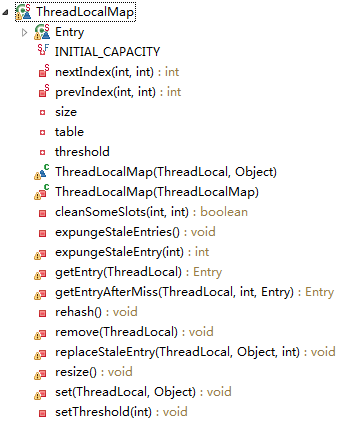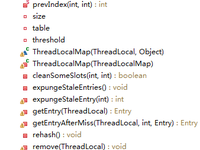上篇讲到了ThreadLocal类(http://maosidiaoxian.iteye.com/blog/1939142),这篇继续讲ThreadLocal中的ThreadLocalMap内部类。
下面先通过一张图,看一下这个内部类的结构:

可以看到在ThreadLocalMap类中,有一个常量,三个成员变量,代码如下:
class="java" name="code">
/**
* The initial capacity -- MUST be a power of two.
*/
private static final int INITIAL_CAPACITY = 16;
/**
* The table, resized as necessary.
* table.length MUST always be a power of two.
*/
private Entry[] table;
/**
* The number of entries in the table.
*/
private int size = 0;
/**
* The next size value at which to resize.
*/
private int threshold; // Default to 0
一个map对象是有一个容量的,INITIAL_CAPACITY 常量表示这个Map的默认的初始化容量。
数组table是一个实体表,保存设置进去的对象,长度必须为2的n次方的值。它是一个Entry类型,Entry类是ThreadLocalMap的一个内部类,继承自弱引用类型WeakReference,定义如下:
static class Entry extends WeakReference<ThreadLocal> {
/** The value associated with this ThreadLocal. */
Object value;
Entry(ThreadLocal k, Object v) {
super(k);
value = v;
}
}
size变量表示实体表里实体的大小,初始值为0;threshold表示表的阈值,默认为0,当实体表的保存的实体大于这个阈值时,就需要对实体表table调整大小了。
现在来看一下ThreadLocalMap实例化的时候做了些什么。
ThreadLcoalMap共有两个构造方法,代码如下:
ThreadLocalMap(ThreadLocal firstKey, Object firstValue) {
table = new Entry[INITIAL_CAPACITY];
int i = firstKey.threadLocalHashCode & (INITIAL_CAPACITY - 1);
table[i] = new Entry(firstKey, firstValue);
size = 1;
setThreshold(INITIAL_CAPACITY);
}
/**
* Construct a new map including all Inheritable ThreadLocals
* from given parent map. Called only by createInheritedMap.
*
* @param parentMap the map associated with parent thread.
*/
private ThreadLocalMap(ThreadLocalMap parentMap) {
Entry[] parentTable = parentMap.table;
int len = parentTable.length;
setThreshold(len);
table = new Entry[len];
for (int j = 0; j < len; j++) {
Entry e = parentTable[j];
if (e != null) {
ThreadLocal key = e.get();
if (key != null) {
Object value = key.childValue(e.value);
Entry c = new Entry(key, value);
int h = key.threadLocalHashCode & (len - 1);
while (table[h] != null)
h = nextIndex(h, len);
table[h] = c;
size++;
}
}
}
}
这两个构造方法,一个为default,一个为private。在上一篇文章提到的,在ThreadLocal里的set方法获取不到这个map,需要创建的时候,它调用ThreadLcoal里的createMap()方法,而createMap()方法则调用default的这个构造方法。而另一个构造方法是在ThreadLocal里的createInheritedMap()中调用的,这个方法会由Thread里的构造方法来调用(在Thread类里的init()方法来调用,而init()方法只被Thread里的构造方法调用),我们在这里就不看它了。
分析一下ThreadLocalMap里带两个参数的这个构造方法,这两个参数为创建这个ThreadLocalMap对象之后的第一对键值对。在构造方法里,先对table进行初始化,默认大小为INITIAL_CAPACITY。然后计算第一对键值对要存放的位置,即在table中的下标,它的代码如下:
int i = firstKey.threadLocalHashCode & (INITIAL_CAPACITY - 1);
我们知道INITIAL_CAPACITY 是一个2的n次幂的值,在这里它为16,即2的4次方,那么INITIAL_CAPACITY - 1 用16进度表示也就是0xF。firstKey.threadLocalHashCode与它作位的与运算,也就是取了threadLocal的哈希值的低4位(当table扩大时,取的值的范围也会跟着增加,但肯定是不大于table的长度的,这一点在ThreadLocalMap里的set方法可以体现出来,而table的长度必须为2的n次也是这种计算方法的前提条件),并将其作为在表中的下标(table的长度也是)。然后为这个键值对在数组相应的下标下创建一个Entry对象,最后设置阈值。在这里它的阈值为table长度的2/3。
在计算下标的时候,从前面的计算方法中我们可以想到一种情况,即两个ThreadLocal对象虽然
他们哈希值不同,但是通过与运算计算出的下标正好相同。对这种情况,它会计算下一个坐标,而下一个坐标则通过当前坐标+1的方式取得,在nextIndex()方法可以看到,代码如下(顺便贴一下prevIndex()方法):
/**
* Increment i modulo len.
*/
private static int nextIndex(int i, int len) {
return ((i + 1 < len) ? i + 1 : 0);
}
/**
* Decrement i modulo len.
*/
private static int prevIndex(int i, int len) {
return ((i - 1 >= 0) ? i - 1 : len - 1);
}
下面我们再来看一下set()方法和get()方法。
先看set()方法,相关代码如下:
/**
* Set the value associated with key.
*
* @param key the thread local object
* @param value the value to be set
*/
private void set(ThreadLocal key, Object value) {
// We don't use a fast path as with get() because it is at
// least as common to use set() to create new entries as
// it is to replace existing ones, in which case, a fast
// path would fail more often than not.
Entry[] tab = table;
int len = tab.length;
int i = key.threadLocalHashCode & (len-1);
for (Entry e = tab[i];
e != null;
e = tab[i = nextIndex(i, len)]) {
ThreadLocal k = e.get();
if (k == key) {
e.value = value;
return;
}
if (k == null) {
replaceStaleEntry(key, value, i);
return;
}
}
tab[i] = new Entry(key, value);
int sz = ++size;
if (!cleanSomeSlots(i, sz) && sz >= threshold)
rehash();
}
/**
* Replace a stale entry encountered during a set operation
* with an entry for the specified key. The value passed in
* the value parameter is stored in the entry, whether or not
* an entry already exists for the specified key.
*
* As a side effect, this method expunges all stale entries in the
* "run" containing the stale entry. (A run is a sequence of entries
* between two null slots.)
*
* @param key the key
* @param value the value to be associated with key
* @param staleSlot index of the first stale entry encountered while
* searching for key.
*/
private void replaceStaleEntry(ThreadLocal key, Object value,
int staleSlot) {
Entry[] tab = table;
int len = tab.length;
Entry e;
// Back up to check for prior stale entry in current run.
// We clean out whole runs at a time to avoid continual
// incremental rehashing due to garbage collector freeing
// up refs in bunches (i.e., whenever the collector runs).
int slotToExpunge = staleSlot;
for (int i = prevIndex(staleSlot, len);
(e = tab[i]) != null;
i = prevIndex(i, len))
if (e.get() == null)
slotToExpunge = i;
// Find either the key or trailing null slot of run, whichever
// occurs first
for (int i = nextIndex(staleSlot, len);
(e = tab[i]) != null;
i = nextIndex(i, len)) {
ThreadLocal k = e.get();
// If we find key, then we need to swap it
// with the stale entry to maintain hash table order.
// The newly stale slot, or any other stale slot
// encountered above it, can then be sent to expungeStaleEntry
// to remove or rehash all of the other entries in run.
if (k == key) {
e.value = value;
tab[i] = tab[staleSlot];
tab[staleSlot] = e;
// Start expunge at preceding stale entry if it exists
if (slotToExpunge == staleSlot)
slotToExpunge = i;
cleanSomeSlots(expungeStaleEntry(slotToExpunge), len);
return;
}
// If we didn't find stale entry on backward scan, the
// first stale entry seen while scanning for key is the
// first still present in the run.
if (k == null && slotToExpunge == staleSlot)
slotToExpunge = i;
}
// If key not found, put new entry in stale slot
tab[staleSlot].value = null;
tab[staleSlot] = new Entry(key, value);
// If there are any other stale entries in run, expunge them
if (slotToExpunge != staleSlot)
cleanSomeSlots(expungeStaleEntry(slotToExpunge), len);
}
在set()方法中,首先通过threadLocal中的哈希值计算下标,判断table中该位置是否存在entry,如果存在,判断entry里的key与value如果与当前要保存的key与value相同的话就不保存直接返回。如果entry里的key为null的话,就替换为当前要保存的key与value。否则就是碰撞的情况了,这时就调用nextIndex()方法计算下一个坐标。
如果计算后的坐标获取到的entry为null,就new一个Entry对象并保存进去,然后调用cleanSomeSlots()对table进行清理,如果没有任何Entry被清理,并且表的size超过了阈值,就会调用rehash()方法。
cleanSomeSlots()会调用expungeStaleEntry清理陈旧过时的Entry。rehash则会调用expungeStaleEntries()方法清理所有的陈旧的Entry,然后在size大于阈值的3/4时调用resize()方法进行扩容。代码如下:
/**
* Expunge a stale entry by rehashing any possibly colliding entries
* lying between staleSlot and the next null slot. This also expunges
* any other stale entries encountered before the trailing null. See
* Knuth, Section 6.4
*
* @param staleSlot index of slot known to have null key
* @return the index of the next null slot after staleSlot
* (all between staleSlot and this slot will have been checked
* for expunging).
*/
private int expungeStaleEntry(int staleSlot) {
Entry[] tab = table;
int len = tab.length;
// expunge entry at staleSlot
tab[staleSlot].value = null;
tab[staleSlot] = null;
size--;
// Rehash until we encounter null
Entry e;
int i;
for (i = nextIndex(staleSlot, len);
(e = tab[i]) != null;
i = nextIndex(i, len)) {
ThreadLocal k = e.get();
if (k == null) {
e.value = null;
tab[i] = null;
size--;
} else {
int h = k.threadLocalHashCode & (len - 1);
if (h != i) {
tab[i] = null;
// Unlike Knuth 6.4 Algorithm R, we must scan until
// null because multiple entries could have been stale.
while (tab[h] != null)
h = nextIndex(h, len);
tab[h] = e;
}
}
}
return i;
}
/**
* Heuristically scan some cells looking for stale entries.
* This is invoked when either a new element is added, or
* another stale one has been expunged. It performs a
* logarithmic number of scans, as a balance between no
* scanning (fast but retains garbage) and a number of scans
* proportional to number of elements, that would find all
* garbage but would cause some insertions to take O(n) time.
*
* @param i a position known NOT to hold a stale entry. The
* scan starts at the element after i.
*
* @param n scan control: <tt>log2(n)</tt> cells are scanned,
* unless a stale entry is found, in which case
* <tt>log2(table.length)-1</tt> additional cells are scanned.
* When called from insertions, this parameter is the number
* of elements, but when from replaceStaleEntry, it is the
* table length. (Note: all this could be changed to be either
* more or less aggressive by weighting n instead of just
* using straight log n. But this version is simple, fast, and
* seems to work well.)
*
* @return true if any stale entries have been removed.
*/
private boolean cleanSomeSlots(int i, int n) {
boolean removed = false;
Entry[] tab = table;
int len = tab.length;
do {
i = nextIndex(i, len);
Entry e = tab[i];
if (e != null && e.get() == null) {
n = len;
removed = true;
i = expungeStaleEntry(i);
}
} while ( (n >>>= 1) != 0);
return removed;
}
/**
* Re-pack and/or re-size the table. First scan the entire
* table removing stale entries. If this doesn't sufficiently
* shrink the size of the table, double the table size.
*/
private void rehash() {
expungeStaleEntries();
// Use lower threshold for doubling to avoid hysteresis
if (size >= threshold - threshold / 4)
resize();
}
/**
* Double the capacity of the table.
*/
private void resize() {
Entry[] oldTab = table;
int oldLen = oldTab.length;
int newLen = oldLen * 2;
Entry[] newTab = new Entry[newLen];
int count = 0;
for (int j = 0; j < oldLen; ++j) {
Entry e = oldTab[j];
if (e != null) {
ThreadLocal k = e.get();
if (k == null) {
e.value = null; // Help the GC
} else {
int h = k.threadLocalHashCode & (newLen - 1);
while (newTab[h] != null)
h = nextIndex(h, newLen);
newTab[h] = e;
count++;
}
}
}
setThreshold(newLen);
size = count;
table = newTab;
}
/**
* Expunge all stale entries in the table.
*/
private void expungeStaleEntries() {
Entry[] tab = table;
int len = tab.length;
for (int j = 0; j < len; j++) {
Entry e = tab[j];
if (e != null && e.get() == null)
expungeStaleEntry(j);
}
}
再下来是get()方法。
/**
* Get the entry associated with key. This method
* itself handles only the fast path: a direct hit of existing
* key. It otherwise relays to getEntryAfterMiss. This is
* designed to maximize performance for direct hits, in part
* by making this method readily inlinable.
*
* @param key the thread local object
* @return the entry associated with key, or null if no such
*/
private Entry getEntry(ThreadLocal key) {
int i = key.threadLocalHashCode & (table.length - 1);
Entry e = table[i];
if (e != null && e.get() == key)
return e;
else
return getEntryAfterMiss(key, i, e);
}
/**
* Version of getEntry method for use when key is not found in
* its direct hash slot.
*
* @param key the thread local object
* @param i the table index for key's hash code
* @param e the entry at table[i]
* @return the entry associated with key, or null if no such
*/
private Entry getEntryAfterMiss(ThreadLocal key, int i, Entry e) {
Entry[] tab = table;
int len = tab.length;
while (e != null) {
ThreadLocal k = e.get();
if (k == key)
return e;
if (k == null)
expungeStaleEntry(i);
else
i = nextIndex(i, len);
e = tab[i];
}
return null;
}
getEntry()方法通过计算出的下标取值,如果取得的entry为null或它的key值不相等,就调用getEntryAfterMiss()方法,否则返回。
而在getEntryAfterMiss()是当通过key直接计算的散列值(也就是计算的下标)取得key时所调用的。这时,如果获取的entry为null,即没有保存,就直接返回null,否则进入
循环不,计算下一个坐标并获取对应的entry,并且当key相等时(表明找到了之前保存的值)返回entry,或是entry为null时退出循环,并返回null。
最后是remove()方法,这个就比较简单了,计算到下标后,如果取得的entry的key与ThreadLocal相同,就调用Entry的clear方法把弱引用设置为null,然后调用expungeStaleEntry对table进行清理。代码如下:
/**
* Remove the entry for key.
*/
private void remove(ThreadLocal key) {
Entry[] tab = table;
int len = tab.length;
int i = key.threadLocalHashCode & (len-1);
for (Entry e = tab[i];
e != null;
e = tab[i = nextIndex(i, len)]) {
if (e.get() == key) {
e.clear();
expungeStaleEntry(i);
return;
}
}
}

- 大小: 15 KB
